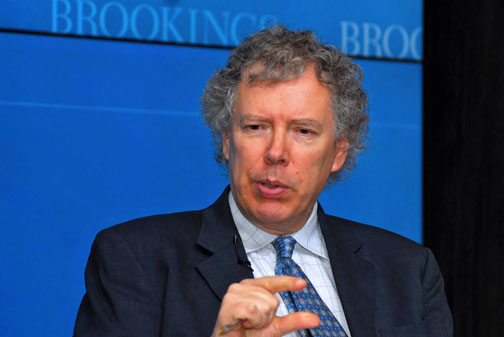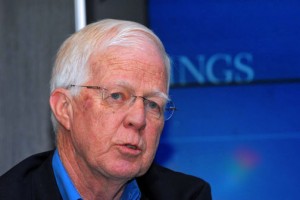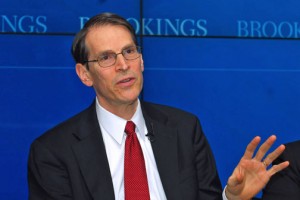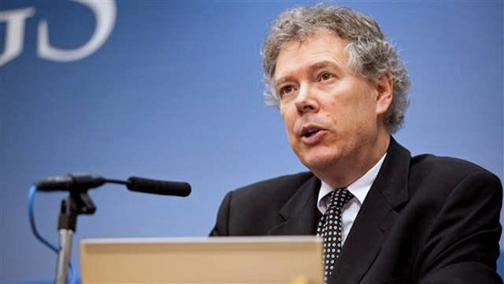Analysts debate Puerto Rico debt crisis at Brookings seminar


Darrell West is vice-president and director of the Brookings Institution’s governance studies program. (Credit: Larry Luxner)
WASHINGTON — More than 100 people crammed into a conference room at one of Washington’s most prestigious think tanks Thursday to hear three experts dissect what exactly caused Puerto Rico’s worsening debt crisis and how to fix it.
That the Brookings Institution — which tackles issues ranging from the Arab-Israeli conflict to global climate change — is even focusing on Puerto Rico for the first time in years is an indication how of severe the crisis is seen on the U.S. mainland.
“Some people have compared the Puerto Rican situation to either Greece or Detroit,” said moderator Darrell West, vice-president and director of governance studies at Brookings. “It is true that Puerto Rico is experiencing grave difficulties. Of nearly $73 billion in debt, about $42 billion of that is government debt. The island also has a substantial budget deficit. The economy has been in or near recession conditions since 2006, and since 2010, Puerto Rico has suffered a net population loss of almost 6 percent.”
Barry Bosworth, senior fellow at Brookings’ economic studies program, sounded a decidedly pessimistic note.
“I think Puerto Rico’s fundamental fiscal problems reflect a lot of mistakes by the government,” he said. “It’s been a collapsing economy for over 25 years, relative to the rest of the country. It’s very hard to devise a turnaround strategy at this point. The sad thing is, Puerto Rico is caught in a downward spiral.”
The numbers are hardly encouraging. Puerto Rico’s unemployment rate stands at 13.5 percent, its poverty rate is 45.4 percent, and real wages dropped by 2 percent last year. Median household income is a measly $19,183, and nearly 38 percent of Puerto Rican families survive on food stamps. Today, Puerto Rico has an estimated 3.6 million inhabitants, down by about 200,000 since 2000.

Barry Bosworth is a senior fellow at the Brookings Institution’s economic studies program. (Credit: Larry Luxner)
“Government debt has reached the limit. If Puerto Rico were a state, everybody would agree that you couldn’t pay all that back. It’s not sustainable,” said Bosworth. “The one big advantage people have in Puerto Rico is that they don’t have to pay federal income tax. But that’s not a very big advantage if you don’t have any income.”
In July, Standard & Poor’s cut the Commonwealth’s general obligation rating to BB from BB+, citing enactment of a new law that lets corporations restructure their debt. It had already been cut to junk-bond status in February. The ratings agency also slashed COFINA’s first lien sales tax bonds to BBB from AA-.
“When we’re looking at speculative grade credit, we’re generally looking at short-term factors,” explained David Hitchcock, senior director at S&P’s state group. “So our primary focus in February, when we downgraded the rating, was liquidity. In particularly, we’re worried about access to the external debt market for cash flow notes. They do need cash flow notes to get them through the fiscal year.
“Also, if operating deficits continue, they would potentially need to access the debt market in order to finance police, fire and other necessary services. There continues to be concerns that if there are deficits, what’s the fallback?”

David Hitchcock is a senior director in the state group at Standard & Poor’s Ratings Services. (Credit: Larry Luxner)
In addition, he said, S&P saw “significant concern about contingent risks, things that could happen very quickly, like acceleration of debt, interest rate swap agreements, variable rate demand bonds that could all come due at once.”
And the short-term future doesn’t look very bright either, Hitchcock warned.
“We see implementation risks. In the past, budgets have been frequently missing their targets, on both the revenues and spending side,” Hitchcock said. “So far, in the first quarter of this fiscal year, they’re off — but not nearly at the level of the previous year. We’ll see how the year progresses. But even if they meet the target, we see structural problems going forward.”
The basic problem is the Commonwealth’s centralized government, said Palmira Ríos-González, acting dean of the University of Puerto Rico’s faculty of social science.

Palmira Ríos-González is the acting dean of the social science faculty at the University of Puerto Rico, and president of the Inter-American Network of Public Administration. She spoke at a Nov. 6 panel at the Brookings Institution about Puerto Rico’s debt crisis. (Credit: Larry Luxner)
“We have a highly centralized government structure that’s the same as it was in 1940. We have a very large executive branch that has spread throughout the island, with 255 agencies not coordinating among each other,” she said. “In Puerto Rico, it’s the central government that delivers services, as opposed to the U.S. mainland, where counties and municipalities do that. In our case, teachers, health workers and others are employees of the central government, not state or local governments.”
Because of that, said Ríos-González, “budgets are constantly increasing, and issuing bonds was always the way of dealing with gaps in funding. The number of employees kept increasing, but the collection of funds was not increasing accordingly, so borrowing was the answer. But like a credit card, we’ve reached our limit.”
But politics always trumps progress, complained Ríos-González, who’s also president of the Inter-American Network of Public Administration.
“All the studies have concluded that we have to change our model. So why can’t we get our act together? Politicians will stop any attempt to restructure,” she said. “Many of the people working in Puerto Rico’s government come about through their participation in political parties. The principle of merit has been practically eliminated. We have a welfare state that is essentially promoting dependency, a state where people receive services without necessarily working. Whether we have the capacity to actually implement the structural changes that are needed is another question.”






